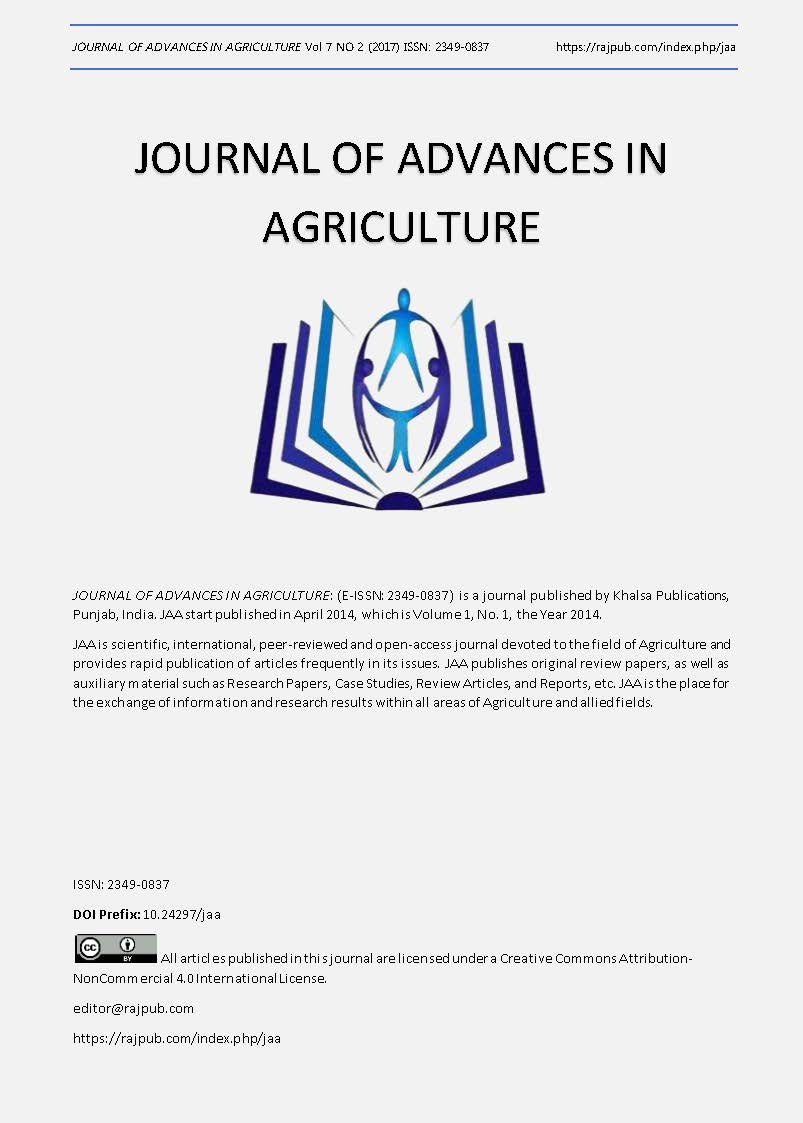EFFECT OF SALINITY ON GROWTH AND PROTEIN CONTENT OF RICE GENOTYPES
DOI:
https://doi.org/10.24297/jaa.v7i2.6205Keywords:
Salinity, Growth, Protein content, Rice, GenotypeAbstract
Rice, the highest producing cereal crops in Bangladesh. Saline induced changes in growth was screened at germination to find out the salt tolerant traditional rice genotypes and chemical tests were carried out to detect the protein-content of rice genotypes. Four traditional rice genotypes (Kalijira, Sakkor khana, Chinigura, Ghoto balam) with one improved variety BRRI dhan28 were used in this experiment. The germination experiment was conducted in petri dish at 0, 8, 12, 16 dS/m salinity with three replications each. Based on the data obtained, the genotypes were scored and categorized as highly tolerant (score 1), tolerant (score 3), moderately tolerant (score 5), susceptible (score 7), and highly susceptible (score 9) to salinity. Salinity caused reduction in germination and declines of shoot length, root length, shoot wet weight and shoot dry weight. Mean salinity tolerance score (MSTS) was computed. Based on MSTS, two genotypes named Kalijira and Chinigura were selected as tolerant, two genotypes named Sakkor khana and BRRI dhan28 as susceptible, and the rest one genotype named Ghoto balam as highly susceptible to salinity in germination stage. Total protein content of rice genotypes were determined by Kjeldahl method. Among 5 varieties studied, Chinigura contains the highest amount of protein (8.855%). The overall data estimated that, Chinigura is more salt tolerant and highly protein rich genotype than other rice genotypes.
Downloads
References
a. rice (Oryza sativa L.) varieties. New Phytol., 88: 363-373.
2. Grattan SR, Zeng L, Shannon MC, Roberts SR 2002: Rice is more sensitive to salinity than previously thought. Califoronia Agriculture 56 189-95
3. Hakim, M. A., A. S. Juraimi, M. Razi Ismail, M. M. Hanafi and A. Selamat (2013) A survey on
a. weed diversity in coastal rice fields of Sebarang Perak in peninsular Malaysia. J.Anim. Pl. Sci. 23(2): 534–542.
4. Hasegawa P, Bressan RA, Zhu JK, Bohnert HJ (2000) Plant cellular and molecular responses to high salinity. Annu Rev Plant Physiol Plant Mol Biol 51:463–499
5. Khan, M.A. and Z. Abdullah (2003) Salinity-sodicity induced changes in reproductive physiology of rice (Oryza sativa) under dense soil conditions. Environ ExpBot. 49: 145–157.
6. Lutts, S., J.M. Kinet and J. Bouharmont. 1995. Changes in plant response to NaCl during
a. development of rice (Oryza sativa L.) varieties differing in salinity resistance. J. Exp. Bot., 46: 1843-1852.
7. Maas EV, Hoffman GJ. 1977. Crop salt tolerance - current assessment. J lrrig Drain Div, ASCE 103 (IR2):115-34.
8. Melo PCS, Anunciacao FCJ, Tabosa JN, Oliveira FJ, Bastos GQ, Melo MRCS 2004: Selection of rice genotype to saline tolerance on germination phase. Revista-Ciencia-Agronomica. 35(2) 361-365
9. Munns R (2002a) Comparative physiology of salt and water stress. Plant Cell Environ 25:239–250
10. Petersen, L and S Shireen. 2001. Soil and water salinity in the coastal area of Bangladesh. Soil Resource Development Institute.
11. Shereen, A, S Mumtaz, S Raza, M A Khan and S Solangi. 2005. Salinity effects on seedling growth and yield components of different inbred rice lines. Pak. J. Bot. 37(1): 131–139.
12. Siringam, K, N Juntawong, S Cha-um and C Kirdmanee. 2011. Salt stress induced ion accumulation, ion homeostasis, membrane injury and sugar contents in salt-sensitive rice (Oryza sativa L. spp. indica) roots under isoosmotic conditions. Afr. J. Biotechnol., 10(8): 1340 1346.
13. US salinity Laboratory Staff 1954: Diagnosis and improvement of saline and alkali soils. Agric. Hard B.60 United States Department of Agriculture. Washington D.C.
Downloads
Published
How to Cite
Issue
Section
License
 All articles published in Journal of Advances in Linguistics are licensed under a Creative Commons Attribution 4.0 International License.
All articles published in Journal of Advances in Linguistics are licensed under a Creative Commons Attribution 4.0 International License.




